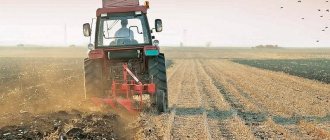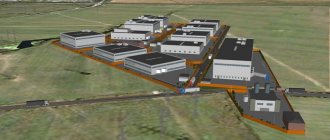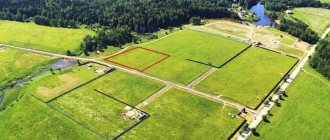IF THE SITE IS NOT USED FOR ITS PURPOSE, THE RATE WILL INCREASE.
In accordance with Art. 389 of the Tax Code of the Russian Federation, land plots, in particular for agricultural purposes, are subject to land tax. But different tax rates are established for plots of different categories (Article 394 of the Tax Code of the Russian Federation).
In general, a rate of 1.5% is applied, but for some categories of land plots it is equal to 0.3%, including for land plots classified as agricultural lands or lands within agricultural use zones in populated areas and used for agricultural production[1]>.
According to Art. 77 of the Land Code of the Russian Federation, agricultural lands are considered to be lands located outside the boundaries of a populated area and provided for agricultural needs, as well as those intended for these purposes.
Agricultural lands include agricultural lands, lands occupied by on-farm roads, communications, forest plantations intended to protect lands from negative impacts, water bodies (including ponds formed by water-retaining structures on watercourses and used for the purpose of pond aquaculture) , as well as buildings and structures used for the production, storage and primary processing of agricultural products.
Owners of land plots and persons who are not owners of land plots are obliged to use land plots in accordance with their intended purpose in ways that should not harm the environment, in particular the land as a natural object (Article 42 of the Land Code of the Russian Federation).
From paragraph 3 of Art. 6 of the Federal Law of July 24, 2002 No. 101-FZ “On the turnover of agricultural land” it follows that the fact of non-use of a land plot for farming or other activities related to agricultural production is established by the state land supervision body.
Before a decision on the forced seizure of such a land plot from its owner is made in court at the request of the said body, at least three years are given, during which this owner can still begin to use the plot for its intended purpose.
For your information:
Signs of non-use of land plots for agricultural production or other activities related to agricultural production are given in the List approved by Decree of the Government of the Russian Federation of April 23, 2012 No. 369 (one of them is sufficient to recognize non-use):
- no work on cultivating crops or cultivating the soil is carried out on the arable land;
- There is no haymaking on the hayfields;
- on cultivated hayfields, the content of weeds in the structure of the grass stand exceeds 30% of the area of the land plot;
- there is no grazing of livestock on pastures;
- In perennial plantings, no maintenance or harvesting work is carried out on perennial plantings and no uprooting of decommissioned perennial plantings is carried out.
- forest and (or) bush cover on arable land exceeds 15% of the land area;
- forest cover and (or) bush cover on other types of agricultural land is over 30%;
- Tussocks and (or) waterlogging account for over 20% of the land area.
The Letter of the Ministry of Finance of Russia dated July 16, 2014 No. 03-05-04-02/34879 [2]> states that if a land plot is recognized by the authorized body as unused for agricultural production, taxation in respect of this entire plot should be carried out at the tax rate established representative body of the municipality in relation to other lands and not exceeding 1.5%, starting from the tax period in which the decision on the identified violation was made, until the beginning of the tax period in which the violation was eliminated (see also Letter of the Ministry of Finance of Russia dated 06/03/2015 No. 03‑05‑04‑02/32131).
According to paragraph 1 of Art. 393 of the Tax Code of the Russian Federation, the tax period for land tax is a calendar year.
Example.
In August 2021, the fact was revealed that the owner of the land plot was not using it for agricultural purposes in accordance with this purpose. In September 2021, it was recognized that this violation had been eliminated.
According to the clarification of the Ministry of Finance, for all reporting periods in 2021, including for the first, second and third quarters, the owner must pay land tax at a rate of 1.5% as for other lands.
For all reporting periods in 2021, land tax is paid at a rate of 0.3% as for agricultural land.
For the reporting periods that passed before either decision was made, updated declarations should be submitted.
The Supreme Court has figured out whether it is possible to take away the land issued “by mistake”
Alushta resident Andrey Ivanov* received almost a hectare of land in 2013. According to documents, it was intended for residential construction. Before the annexation of Crimea, he was allowed to lease the land, then he was allowed to draw up a project for its transfer into ownership, and in 2014, after the annexation, Ivanov asked to be given ownership of the land. The city administration gave him the site free of charge; in the “type of permitted use” column it was listed as “low-rise residential development.” A year later, Ivanov donated the land to his mother. By that time, there was already a house on the site; ownership of both it and the land was registered in the name of Ivanov’s mother.
But the city administration decided that they had made a mistake. The land in question could only be leased and not owned, since part of the site is located on public green space. In this case, it is impossible to transfer the site for development, government agencies concluded. To rectify the situation, the administration filed a lawsuit. Representatives of the city wanted to invalidate their own resolution on the transfer of land to Ivanov and oblige him to return the land to the city.
At first instance the demands were considered reasonable. They indicated that the right to lease did not imply the provision of ownership of the site, and Ivanov’s argument that the city gave him permission to draw up a land management project for the transfer of ownership of the site was not accepted, because such a decision was not the basis for providing Ivanov with land after that. how Crimea was annexed and the rules changed (Decision of the Alushta City Court of the Republic of Crimea, case No. 2-74/2018 (2-1463/2017;) ~ M-1386/2017). In the appeal, the decision was supported, but it was recognized that Ivanov could further register the plot (Appeal ruling of the Supreme Court of the Republic of Crimea, case No. 33-4804/2018).
The Supreme Court explained how alimony debts are inherited
But the Supreme Court considered this approach to be incorrect (case No. 127-KG19-2). The Collegium for Civil Disputes, chaired by Judge Gorshkov, in the ruling on the case indicated that if the registration of rights to plots in Crimea was started before the law on the annexation of Crimea was adopted, then it is carried out on the basis of decisions of local governments adopted before March 21, 2014 year and in force on that date. Ivanov, justifying the right to the site, referred to the administration’s decision made before this date and regarding permission to draw up a project for transferring ownership of the site. This decision was not cancelled, the Supreme Court indicated. Moreover, in the appeal it was recognized that the applicant has the right, based on this decision, to register the plot for himself.
According to the Supreme Court, the court had to evaluate the administration’s decision and resolve the question of whether Ivanov has the right to receive land in this manner or not. And if such a right exists, then it is impossible to cancel the decision on the transfer of ownership of the plot. In addition, the courts had to pay attention to the sequence of actions of the administration in providing the site.
“It was necessary to assess whether depriving them of their property rights and shifting the burden of the local government’s miscalculations onto them was consistent with the provisions on respect for the right to private property and the protection of this right,” the Supreme Court said in its ruling in the case.
The Supreme Court sent the case for a new appeal (case No. 33-6415/2019, not yet considered). The question of whether it is generally acceptable to expose private individuals to the risk of negative consequences arising from the fault of government agencies is also raised in case No. A56-48136/2017. Here, the local government authority, on the recommendation of the prosecutor, canceled the previously issued construction permit, which negatively affected the interests of the developer. The Supreme Court indicated that a local government body has the right to cancel a permit if it turns out that it is contrary to the law. The case was sent for a new trial to the court of first instance.
It is too early to talk about a developed approach to resolving this type of case, says Yuri Vodopyanov, lawyer at Land Law Firm Land Law Firm Federal Rating. group Land law/Commercial real estate/Construction group Dispute resolution in courts of general jurisdiction group Private capital group Arbitration proceedings (major disputes - high market) Company profile. Due to the fact that there is no clearly defined approach and criteria for the courts, it is difficult to assess the chances of a citizen in such a situation. In general, we can talk about the beginning of the formation of a positive trend in this category of disputes, Vodopyanov believes: “The increased attention of the Supreme Court to the issues of respecting the rights and interests of private individuals when interacting with public entities is an extremely positive sign for Russian justice.”
But since a citizen’s chances of winning in such a situation are uncertain, it is better to simply not get into such a situation. There are two main options here. The first is to contact a specialist in the field of land and property relations, who will conduct due diligence of the land plot before signing an agreement with the local government body. The second is to check everything yourself, carefully analyzing the urban planning documentation.
Urban planning documentation: what to pay attention to?
– Urban zoning map (posted on the official website of the municipality) to determine the territorial zone in which the site is located.
– Land use and development rules to determine what objects can be placed on land plots located in this territorial zone.
– Map of territories with special conditions of use to ensure that the land plot does not fall partially or completely into such a zone (protection zone of infrastructure facilities / protection zone of cultural heritage sites / sanitary protection zone of enterprises, etc.). The placement of objects in such territories is usually significantly limited or prohibited.
– A draft site plan, which is also publicly available, to ensure that the boundaries of the land plot do not cross the “red lines”.
– Contact your local architecture and urban planning authority to inquire about any restrictions on the site, because some documents on the Internet are not updated in a timely manner and the information may not be current.
If the provision of a land plot is nevertheless declared invalid and the owner is obliged to return the land, then he can seek compensation for losses. This possibility is provided for in Art. 16 Civil Code.
“The liability of public entities for private torts is a rather sensitive issue for the Russian legal order, which is why there is very little positive practice on this issue,” admits Vodopyanov.
Thus, in 2021, the Arbitration Court of the Volga District recovered from a public law entity damages caused to a person due to the cancellation of decisions on the provision of land (Resolution No. F06-29058/2017 in case No. A65-19957/2016). Moreover, at the time the decisions were declared illegal, the plaintiff had already incurred the actual costs of implementing the investment project. The court found the local government body guilty of causing losses and satisfied the plaintiff's claims. A similar approach is expressed in the Resolution of the Central District Court in case No. A64-1335/2011. But so far, cases of recovery of damages from public legal entities are the exception rather than the rule.
* – the names and surnames of the parties to the dispute have been changed.
- Irina Kondratyeva
IF THE VIOLATION WAS SHORT-TERM.
A conscientious business entity, if it is revealed that the land plot is not being used for agricultural purposes, tries to correct the violation as quickly as possible. Perhaps he will be able to do this in the same tax period when the violation was recorded.
On this issue, the Letter of the Ministry of Finance of Russia dated August 23, 2017 No. 03-05-04-02/54186[3] notes that the Tax Code of the Russian Federation does not define the procedure for applying the tax rate for a land plot classified as agricultural land or land within zones agricultural use in populated areas, which is not used for agricultural production, if the authorized body of state land supervision during the tax period identified an offense related to the non-use of the land plot for agricultural production, and the taxpayer eliminated this offense in the same tax period.
Officials recalled that, according to paragraph 7 of Art. 3 of the Tax Code of the Russian Federation, all irremovable doubts, contradictions and ambiguities in acts of legislation on taxes and fees are interpreted in favor of the taxpayer.
In this regard, in their opinion, in this case, the calculation of the amount of land tax should be made according to the tax rates established by the regulatory legal acts of the representative bodies of municipalities (laws of the federal cities of Moscow, St. Petersburg and Sevastopol) in accordance with paragraphs. 1 clause 1 art. 394 Tax Code of the Russian Federation.
That is, during the entire tax period, the reduced tax rate established for agricultural land should be applied.










